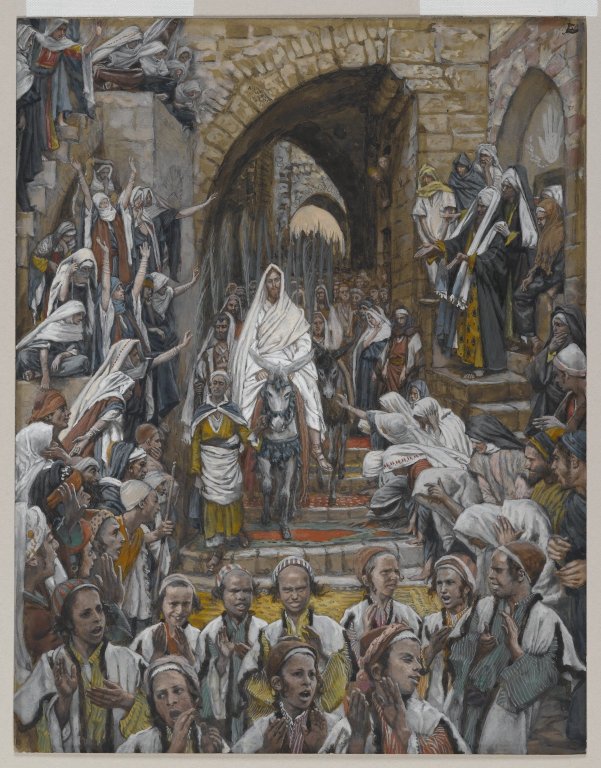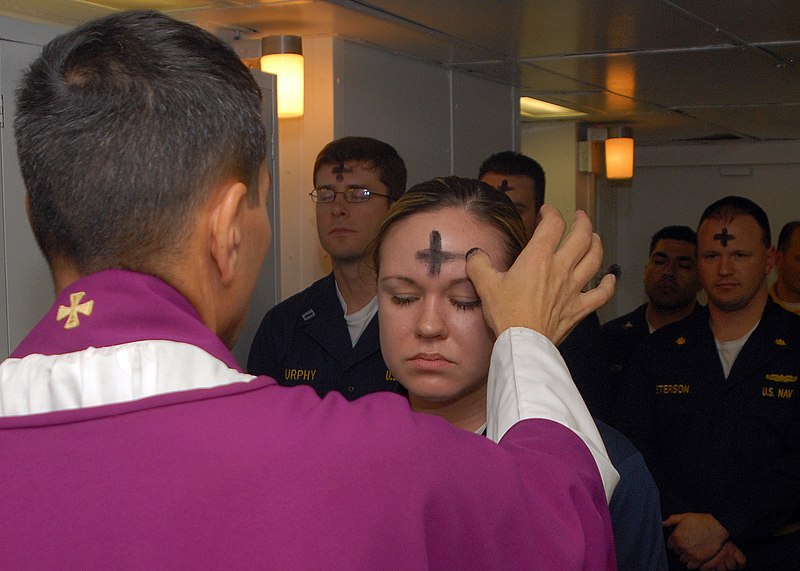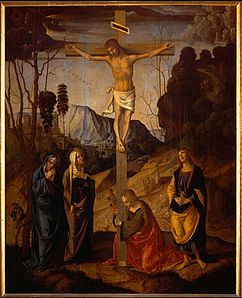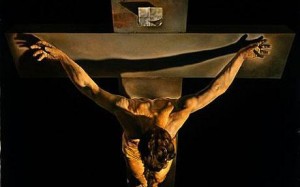
Holy Week started with “Jesus riding on a donkey in his triumphal entry into Jerusalem …”
* * * *
 Holy Week is upon us. It’s the last week of Lent. (Which started back on March 1, with Ash Wednesday, as shown at right). And it’s the week that leads up to Easter Sunday. (This year, April 16.)
Holy Week is upon us. It’s the last week of Lent. (Which started back on March 1, with Ash Wednesday, as shown at right). And it’s the week that leads up to Easter Sunday. (This year, April 16.)
Holy Week begins with Palm Sunday and includes “Holy Wednesday (also known as Spy Wednesday), Maundy Thursday (also known as Holy Thursday), Good Friday (Holy Friday), and Holy Saturday.”
Which sets up the reference to Psalm 22. It was a Daily Office Reading for Friday, April 7, and Psalm 22 is inextricably intertwined with the “Passion of Jesus.” (A reference to the “2004 American biblical epic drama film directed by Mel Gibson,” alluded to in the post title.)
 Scholars believe that Psalm 22 was written some 600 years before Jesus was born. (That is, in the “pre-exilic period … before the Babylonian destruction of Jerusalem in 587.“) The first words of the Psalm – at least in the Latin Vulgate translation of the Bible, shown at left – are “Deus, Deus meus.” In English we know the verse better as “My God, my God, why have you forsaken me?”
Scholars believe that Psalm 22 was written some 600 years before Jesus was born. (That is, in the “pre-exilic period … before the Babylonian destruction of Jerusalem in 587.“) The first words of the Psalm – at least in the Latin Vulgate translation of the Bible, shown at left – are “Deus, Deus meus.” In English we know the verse better as “My God, my God, why have you forsaken me?”
We know that verse well because that’s the psalm Jesus quoted on the cross, as told in Matthew 27:46: “About the ninth hour, Jesus cried out in a loud voice, ‘Eli, Eli, lema sabachthani?’ which means, ‘My God, My God, why have you forsaken Me?'” (See also Mark 15:34.)
What most people don’t realize is that Psalm 22:1 goes on: “Why are you so far from saving me, so far from my cries of anguish?” (And that’s a thought many have had from time to time…)
Then there is Psalm 22, verse 16, which reads in part, “they pierce my hands and my feet.”
Which is pretty much what they did to Jesus at the Crucifixion.
 In that historical method of capital punishment – as shown at right – “the victim is tied or nailed to a large wooden beam and left to hang for several days until eventual death from exhaustion and asphyxiation.”
In that historical method of capital punishment – as shown at right – “the victim is tied or nailed to a large wooden beam and left to hang for several days until eventual death from exhaustion and asphyxiation.”
(But see also 10 Misconceptions About Jesus: [He] was pierced through His hands. The article noted among other things that there was a “translation difficulty” involving the original Greek word usually translated as hand: “The word xeiros, which we translate to ‘hand’ has a wider semantic range.” Then there is the fact that – anatomically speaking – the “bones and tendons of the hand simply do not have the strength to hold the weight of the body without the nail ripping through. The easiest and strongest place to hammer a nail is through the wrist, between the ulna and radius bones.”
And finally comes Psalm 22:18. In the NIV it reads: “They divide my clothes among them and cast lots for my garment.” That verse from Psalm 22 was mirrored in Matthew 27:35: “When they had crucified Him, they divided up His garments by casting lots.”
So, in order, Matthew 27 tells first of Judas Iscariot hanging himself for betraying Jesus. Then comes “Jesus Before Pilate,” followed by “The Soldiers Mock Jesus” and “The Crucifixion of Jesus.” Finally there is “The Death of Jesus,” with its three references to Psalm 22.
 The first reference came with the Crucifixion (Matthew 27:32-44), when Roman soldiers nailed Jesus to the cross. They fulfilled the prophecy in Psalm 22:16, which notes, “they pierce my hands and my feet.” (Or feet and wrists, depending on the translation of the Greek word “xeiros.”) Then came Matthew 27:35, “When they had crucified him, they divided up his clothes by casting lots.”
The first reference came with the Crucifixion (Matthew 27:32-44), when Roman soldiers nailed Jesus to the cross. They fulfilled the prophecy in Psalm 22:16, which notes, “they pierce my hands and my feet.” (Or feet and wrists, depending on the translation of the Greek word “xeiros.”) Then came Matthew 27:35, “When they had crucified him, they divided up his clothes by casting lots.”
And finally, in Matthew 27:46 Jesus quotes Psalm 22:1, crying out “in a loud voice, ‘Eli, Eli, lema sabachthani?’ which means, ‘My God, My God, why have you forsaken Me?’”
All of which is pretty depressing, at first blush. But here’s a spoiler alert: There is a happy ending, and we get to find out all about it next Sunday…
* * * *

Another hint: Good Friday leads to the happy ending…
* * * *
The upper image is courtesy of Palm Sunday (Wikipedia). The full caption: “Jesus riding on a donkey in his triumphal entry into Jerusalem depicted by James Tissot.” I used the image in 2015’s On Holy Week – and hot buns. See also On Holy Week – 2016.
The full readings for Friday April 7 were “AM Psalm 95 & 22; PM Psalm 141, 143:1-11(12)
Jer. 29:1,4-13; Rom. 11:13-24; John 11:1-27 or 12:1-10.”
For further information on Psalm 22:16 see They have pierced my hands and my feet – Wikipedia.
The “crucifixion” image is courtesy of the Wikipedia article. The caption: “‘Crucifixion of Jesus’ by Marco Palmezzano (Uffizi, Florence), painting c. 1490.”
The lower image is courtesy of Passion of the Christ – Wikipedia. The full caption for this theatrical release poster reads: “This is a poster for the MOPTOP #1 The Passion of the Christ. The poster art copyright is believed to belong to the distributor of the film.” Further provisos: 1) Under the heading Portion Used: “The entire poster: because the image is poster art, a form of product packaging or service marketing, the entire image is needed to identify the product or service, properly convey the meaning and branding intended, and avoid tarnishing or misrepresenting the image.” 2) Under Other information: “Use of the poster art in the article complies with Wikipedia non-free content policy and fair use under United States copyright law as described above.”